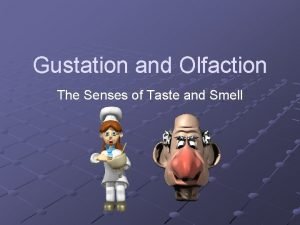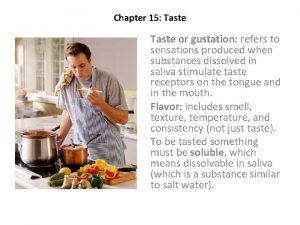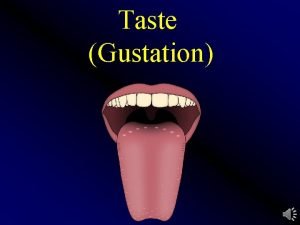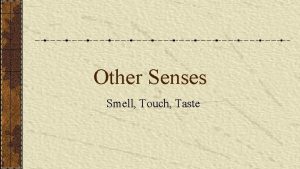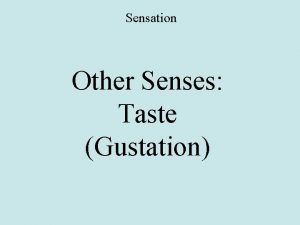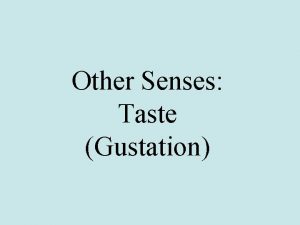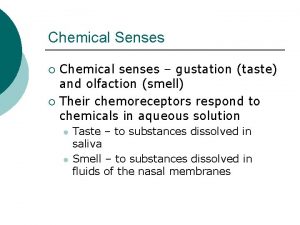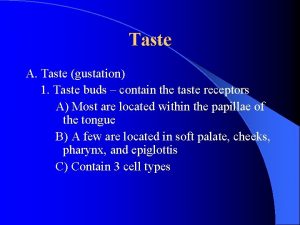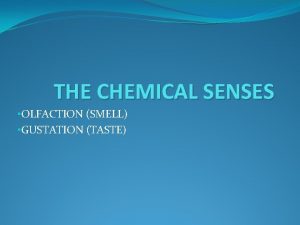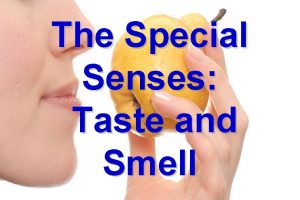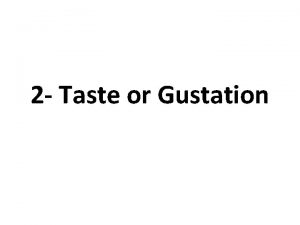Topic 3 6 Chemical Senses Taste Gustation We












- Slides: 12

Topic 3. 6 - Chemical Senses

Taste (Gustation) • We have bumps on our tongue called papillae. • Taste buds are located on the papillae (they are actually all over the mouth). • Taste sensations: Sweet, salty, sour, bitter and umami (Japanese for savory)

Taste • Some taste sensations are genetically programmed, such as sweet, and finding bitter and sour foods unpleasant • A study of babies had sweet tastes eliciting smiles, lip smacking, and sour tastes eliciting protrusion of tongue- what could this mean?

Smell (Olfaction) Olfactory nerve Olfactory bulb Nasal passage Receptor cells in olfactory membrane

Smell (Olfaction) • We smell something when molecules of a substance carried in the air reach a tiny cluster of 5 million or more receptor cells at the top of each nasal cavity • The ability to identify scents peaks in early adulthood and gradually declines thereafter • The attractiveness of certain smells depends on learned associations- this will be the focus of Unit 4 • Why can smells elicit powerful memories? Could brain circuitry explain it?

So how are smell and taste related to each other? • Although smell and taste have their own separate receptors, there is little doubt that they are closely linked • When your sense of smell is impaired (a cold, for example), is the taste of your food impacted? • We can argue that “flavor” of the food is the intersection of smell and taste

Topic 3. 7 - Other Senses

Touch • Skin sensations include pressure, warmth, cold and pain. • Only pressure has identifiable receptors • Touch sensations involve more than tactile stimulation- for example, why can’t we tickle ourselves?

Gate-Control Theory • theory that the spinal cord contains a neurological “gate” that blocks pain signals or allows them to pass on to the brain • “gate” opened by the activity of pain signals traveling up small nerve fibers • “gate” closed by activity in larger fibers or by information coming from the brain

How do we feel pain? • Pain is an important signal to our bodies • The experience of pain can be influenced by information from the brain • Chronic pain—est. that over 100 million people suffer from this • One study had teen age burn patients undergo a few minutes of wound treatment while they played Nintendo or while they were in a VR environment—the patients felt less pain and spent less time thinking about their pain in virtual reality than Nintendo due to concept of “presences”—illusion of going inside another world. • The big takeaway: Pain requires attention

Vestibular Sense • Tells us where our body is oriented in space. • Controls our sense of balance. • Located in semicircular canals and vestibular sacs in our inner earcan be disrupted by sudden motion or rotation, causing temporary loss of balance. Think about a merry-go-round or a dizzy bat race

Kinesthetic Sense • Tells us where our body parts are in terms of position and movement. • Sensors located in our joints, tendons, bones and ears. • What would happen if this sense was permanently damaged? Look at Ian Waterman’s story This Photo by Unknown author is licensed under CC BY-NC.
 Facts about taste
Facts about taste Messiners
Messiners What is the difference between somatic and special senses
What is the difference between somatic and special senses 5 taste senses
5 taste senses Gustation and olfaction
Gustation and olfaction Gustation refers to
Gustation refers to Thanks for your attention doctor
Thanks for your attention doctor Painted paragraph strategy
Painted paragraph strategy Broad topic and specific topic examples
Broad topic and specific topic examples Section 1 chemical changes
Section 1 chemical changes Section 2 reinforcement classifying chemical reactions
Section 2 reinforcement classifying chemical reactions Trinitrogen monosulfide formula
Trinitrogen monosulfide formula Empirical formula pogil
Empirical formula pogil




